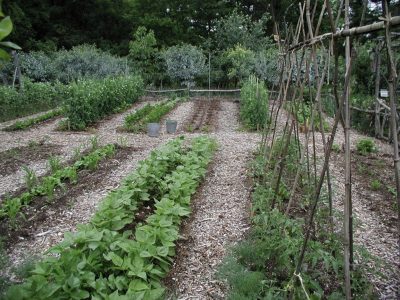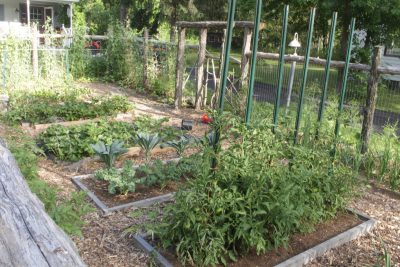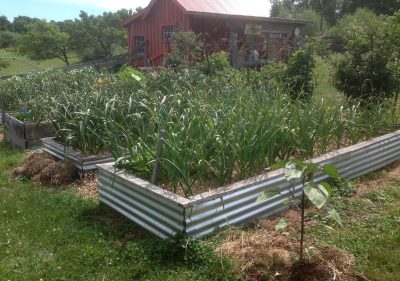Bedding Down
Flat Beds
My vegetable garden is in beds. Your vegetable garden is in beds. Seems like just about everybody plants in beds these days. And with good reason. Beds make more efficient use of garden space. Soil compaction is avoided because planting, weeding, pruning, and harvesting can be done with feet in the paths. And the shapes of the beds can help make even a vegetable garden look prettier, especially with decorative plants edging the beds.
Raised beds are also one way to grow happy plants in otherwise poorly drained ground, or in ground that has been contaminated by lead or arsenic. Such contamination is likely to occur from past use of leaded gasoline near roadways, from old paint near buildings, and from residual pesticides in sites that were once orchards.
My vegetable garden is laid out in 3-foot-wide beds with 18-inch-wide paths between them that feed into one 5-foot-wide path down the center of the garden. Many gardeners, when considering planting in beds, equate that with RAISED beds. My vegetable beds are not intended to be raised even a hair above the paths.
When I began my garden, I laid out the beds and covered them with compost, and then laid wood chips from local arborists in the paths. The difference in appearance of the two materials makes it easy to see where to walk and where not to walk. (For most people, that is. A well-known food writer once visited my garden. As I walked up a path, he tromped along next to me — right up the middle of the bed adjacent to the path! — until I let out a scream that brought him to an abrupt stop. Some lush plants in the bed were admittedly flopping onto the path, obscuring the difference between walking and planting areas.)
Raised Beds
Soil in raised beds is usually held there with boards or other edging. That edging material might itself be decorative: lumber, bricks, roof tiles, or, in a “colonial” garden, logs.
Ideally, any wooden edging is rot resistant. Locust or redwood would be my top choices, but hard to get. “Manufactured” lumber, such as Trex, is another possibility. Then again, pine or spruce boards are readily available, relatively inexpensive, and should last quite a few years.
A six-inch-high bed provides enough well-drained root depth for pretty much all vegetable plants.
One disadvantage to raised beds is that you have get soil to fill them up. That soil could, of course, come from what will be the paths.  If the area is wet, though, taking soil from paths is going to lower them, making them that much wetter.
If the area is wet, though, taking soil from paths is going to lower them, making them that much wetter.
Most people bring in soil for raised beds, and, in the interest of having the best possible garden, make that “soil” compost. Not a good idea. For one thing, compost is mostly “organic matter,” meaning compounds of carbon, hydrogen, and oxygen. With time, as organic matter decomposes to nourish soil microorganisms and plants, it disappears, literally, becoming carbon dioxide and water. So a raised bed filled with compost will eventually shrink down to almost nothing.
The thing to do is to fill beds almost to their brims with any any well-drained soil. Fertility is not important; that will come from the one to two inches of compost with which the soil is topped. Replenishing the compost each year will provide all the nutrition plants need for that year; no additional fertilizer is necessary. And no need to dig or rototill the compost into the ground.
One more thing about raised beds: The improved drainage also means that they dry out faster, so benefit from irrigation.
Table-like Beds, Not
If you were to walk into my garden, you might notice that my planting beds are indeed a bit higher than the paths. This was not deliberate.
Each year for many years I’ve topped all my beds and an inch or two of compost. Paths get replenished with wood chips only if they start to get weedy or bare soil starts peeking through.
Paths get replenished with wood chips only if they start to get weedy or bare soil starts peeking through.
If it weren’t for decomposition, those yearly additions of compost would have made each bed into a “table” more than three feet high. It hasn’t. Q.E.D.

